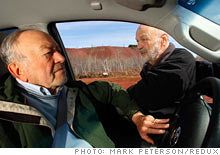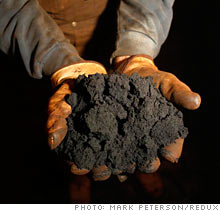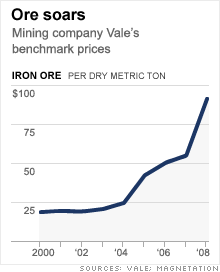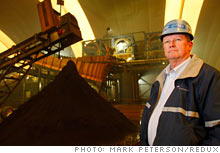The next iron rush
Once upon a time, Minnesota's Iron Range was famous for minting millionaires. Thanks to a new technology that promises to turn refuse into usable iron, history might repeat itself.
 |
| The Hull-Rust-Mahoning Mine in Hibbing, Minn. is the largest open-pit iron ore mine in the world. |
 |
| Company co-founders Fritz, 78 (right), and Hunt, 83, in front of giant tailings piles they hope to turn into iron concentrate using using magnetation. |
 |
| An ironworker clutches a handful of iron ore concentrate, which can be shipped for use. |

 |
| Magnetation CEO Larry Lehtinen inside the company's plastic-film-enclosed plant where tailings are processed. |
 |
| Tailings, seen in the background, could be a boon for familiies in the range, where the unemployment rate hovers at 13.5%. |
(Fortune Magazine) -- Gazing across the craggy canyon that is the Hull-Rust-Mahoning mine in Minnesota's legendary Iron Range, it's hard to believe that our planet's most abundant element - iron - is mostly locked away in the earth's core. For here iron-bearing rock has shouldered its way to the surface in heroic quantities, and men and machines have carved out the world's largest iron-ore pit. And as it has for over a century, Range iron still forges the steel sinews of the American economy.
But more than a century of mining has left Iron Country scraped and scarred, a landscape dominated by vast quarries and basins of stony waste from processed ore - tailings, which sprawl across the land like a mighty river delta. Now largely covered by scrub vegetation, these tailings are the remains of a struggle to wrest a living from the earth that began with the great Iron Rush of the 1880s. Fortune hunters from far afield flocked to the rich hematite mines of the Vermilion and Mesabi ranges, which were soon minting millionaires so fast that by 1910 regional capital Duluth was reckoned to have more than any other city in the world.
Two world wars brought boom times as the Range answered the call for iron and steel to arm the nation. And there were busts too, notably during the Depression, when output crashed from 47 million metric tons in 1929 to just 2 million metric tons in 1932. And all the time those tailings kept accumulating - a buildup that will continue until the ore runs out. Then the Range will fall silent, closing a long chapter of American history.
Or maybe not. Just west along Route 169 from the Hull-Rust-Mahoning mine, near the town of Keewatin (pop. 1,164), a vast domed structure dominates a tailings basin left by the defunct Mesabi Chief mine. The dome can't be seen from the highway, and few Rangers (and even fewer mining corporations) know it's there. Inside sits equipment that could prove to be as significant to the region as the 1950s-era discovery of a way to extract iron from low-grade taconite rock. The earlier technique arrived in the nick of time for the Range, for its hematite - known locally as "natural" ore - was almost depleted. Similarly, the dome at Keewatin is home to a revolutionary process, dubbed "magnetation," that can extract valuable iron from the tailings - just when the Range is in need of new sources of ore.
"Our process," says Rod Hunt, 83, who, along with mining veteran Al Fritz, 78, co-founded upstart Magnetation Inc., "is the equivalent of the fabled philosopher's stone of yore. We can't turn base metal into gold, but we can process the millions of tons of natural-ore tailings and extract the iron that got missed the first time around."
That's good news for the hardscrabble region (March unemployment there was 13.5% - the highest rate since 1992) and explains why Iron Range Resources, a state development agency, has backed the company with $2.5 million in seed money. But magnetation technology also is good news for the iron industry globally. U.S. Geological Survey data show that global reserves of economically recoverable iron ore could eventually run out. "Magnetation is a transformational technology," says former regional development consultant Mike Andrews. "If it didn't exist, it would have to be invented."
Behind the invention stands a grizzled bunch of veterans with more than three centuries of mining, construction, and engineering experience among them. Magnetation's iron men seem more like Minnesota's answer to the Buena Vista Social Club than mining messiahs, but they apparently have developed a technology that has defied the best efforts of bigger players.
Process inventor Fritz is characteristically modest about his achievement. "The last half-century hasn't seen many new developments in mining," he says. "I guess we lucked onto one." But it wasn't so much luck as dogged determination that enabled Fritz, formerly superintendent of the Hill Annex mine, to tweak the process during his retirement. The breakthrough came three years ago when Fritz and Hunt, who first met prospecting for gold in Alaska back in the 1980s, bench-tested a prototype machine - which they dubbed the "ferrous wheel" - that finally solved the problem of creating a magnetic field capable of extracting enough of the weakly magnetic hematite to make commercially viable iron-ore concentrate.
"We weren't getting any younger, so we decided it was time to go into business," recalls Hunt, who had the additional motive of recouping enough funds to repay the mortgage he had taken out on his house to pay for the prototype.
They were soon joined by Ed Shaughnessy, 57, a mining project manager for 30 years when he wasn't racing dragsters, who just happened to own some tailings - about 4 million metric tons of them that came his way in 1998 when the businessman who hired him to build a drag-racing strip on the tailings failed to pay up. Next came two other Range veterans: haulage and construction contractor Tom Hammerlund Sr., 67, who had heard about Magnetation's contraption through Shaughnessy, and engineer Eugene Bergstrom, 71, who liked the sound of it so much that he sold his resort business on nearby Lake Winnibigoshish to invest in the Keewatin startup.
The big coup for Hunt and Fritz was persuading Larry Lehtinen, the youngster of the group at 53 but with 30 years' experience in the iron and steel business, to come onboard as CEO. A man of vision and energy in the mold of the Range's early pioneers - like his great-grandfather Albert, who arrived from Finland in 1896 - Lehtinen has a reputation for making things happen. Recalls Hunt: "Al and I had faith in the process, but Larry and the others got us out of the lab and into production."
***
Magnetation's first challenge was to show that its patent-pending technology could indeed extract the "lost" iron. This it has done emphatically - since Feb. 23 its plant has been shipping concentrate rich enough for blast furnaces to turn it into pig iron, the raw material for steel.
Now it must compete price-wise with the world's mining giants. Magnetation will never match them on volume: Brazilian mining behemoth Vale (VALE), the world's largest iron ore producer, ships about 250 million metric tons annually, compared with Magnetation's tiny initial target of 300,000 metric tons. But Lehtinen is certain that Magnetation can compete on price. Although he won't discuss costs, Lehtinen insists that Magnetation is already the lowest-cost producer in the U.S. and can match Vale, as well as mining giants BHP Billiton (BHP) and Rio Tinto (RTP), all of which must ship their ore long distances to their main customers.
"Our raw material is all around us," Lehtinen explains. "It's easy and cheap to extract, and it has already been crushed." Indeed, the main input is the water needed to convert the tailings into a mudlike slurry that can be fed through the magnetation process, where, as the name suggests, giant magnets separate the weakly magnetic hematite from the nonferrous elements of the tailings - mainly silica. And thanks to Shaughnessy's 150-acre tailings basin, getting started was relatively easy.
"I got a whole lot of grief from my wife for those tailings," recalls Shaughnessy, "but now they don't look so worthless." Far from it. Shaughnessy's tailings could yield as much as a million metric tons of concentrate, worth around $90 million at current prices. And Magnetation has lined up enough tailings to produce 104 million metric tons of concentrate, worth just under $10 billion.
-
 The retail giant tops the Fortune 500 for the second year in a row. Who else made the list? More
The retail giant tops the Fortune 500 for the second year in a row. Who else made the list? More -
 This group of companies is all about social networking to connect with their customers. More
This group of companies is all about social networking to connect with their customers. More -
 The fight over the cholesterol medication is keeping a generic version from hitting the market. More
The fight over the cholesterol medication is keeping a generic version from hitting the market. More -
 Bin Laden may be dead, but the terrorist group he led doesn't need his money. More
Bin Laden may be dead, but the terrorist group he led doesn't need his money. More -
 U.S. real estate might be a mess, but in other parts of the world, home prices are jumping. More
U.S. real estate might be a mess, but in other parts of the world, home prices are jumping. More -
 Libya's output is a fraction of global production, but it's crucial to the nation's economy. More
Libya's output is a fraction of global production, but it's crucial to the nation's economy. More -
 Once rates start to rise, things could get ugly fast for our neighbors to the north. More
Once rates start to rise, things could get ugly fast for our neighbors to the north. More







